Thekchen Chöling, Dharamsala, HP, India - This morning, the Kashag, the cabinet of the Central Tibetan Administration, offered prayers for his long life to His Holiness the Dalai Lama on behalf of the Tibetan people. As he reached the Tsuglagkhang, the Main Tibetan Temple, His Holiness was greeted by several of the guests—Shri Pema Khandu, Chief Minister of Arunachal Pradesh, Shri Tashi Gyalson, Chief Executive Councillor (CEC), Ladakh, Shri Kiren Rijiju, Union Minister of Parliamentary Affairs, GOI and Shri Sonam Lama, Minister for Ecclesiastical Affairs of Sikkim. Inside the temple Ganden Trisur Rinpoché and Sakya Gongma stepped forward to welcome him.
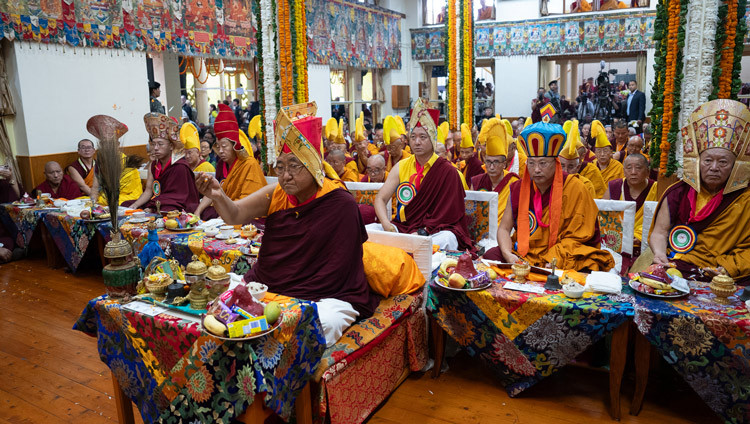
His Holiness took his seat on the dais, while Sakya Gongma Trichen Rinpoché, the presiding master of the ceremony, sat before him. Behind him was Sakya Trizin to whose right sat the Ganden Tri Rinpoché, Taklung Shapdrung, Khenpo Ngedo, and Minling Khenchen. To his left were Menri Trizin, Drikung Chetsang Rinpoché, Khenpo Donyo and Jonang Gyaltsab.
In the elaborately decorated temple courtyard there were photographs of His Holiness at different stages of his life, as well as peace champions—Nelson Mandela, Mahatma Gandhi, Martin Luther King Jr and Mother Teresa.
Prayers began with the seven-line invocation of Guru Padmasambhava, a prayer for the welfare of Tibet and continued with the main ritual for longevity based on a prayer to Amitayus written by the Great Fifth Dalai Lama.
Sakya Gongma Rinpoché was standing before His Holiness paying homage to the Guru on the lion throne when the Tsering Che-nga oracle approached in trance. She made her own offerings as Sakya Gongma continued to follow the ritual he was leading. Next, the Kharak Khyung Tsün oracle appeared and approached the throne to offer representations of the body, speech and mind of the Buddha together on a tray. The Nechung Oracle appeared in trance and offered the three representations directly to His Holiness. He then saluted the chief Lamas and leading members of the CTA. His Holiness the Dalai Lama received the various oracles, their offerings and prayers with an air of fondness.
A long-life prayer by Jamyang Khyentsé Chökyi Lodro, Song of the Nectar of Immortality was recited.
The Dorjé Yudrönma oracle appeared in trance, dancing energetically, followed by the Nyenchen Tangla oracle. The oracles would approach His Holiness, turn away, focussing their attention elsewhere, throwing handfuls of coloured grain by way of blessing, and then returned to His Holiness once more. As their trances came to an end the mediums crumpled up and were swiftly carried out of the temple by their attendants.
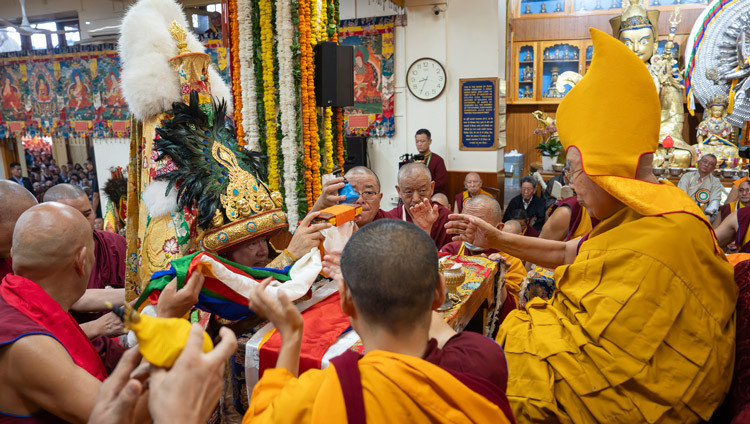
A tsog offering was made with the wish, “By this may we overcome all obstacles.”
A steady procession of members of CTA staff carrying offerings—sacred images, scriptures and so forth—to be presented to His Holiness filed through the temple. Sakya Gongma Rinpoché led the offering of a mandala in which the Sikyong, Speaker and Justice Commissioner took part. He then offered three representations of the Buddha’s body, speech and mind, a statue of Amitayus, a scripture and a stupa, followed by a vase of immortality. This he followed with offerings of the nectar of longevity, and long-life pills. His Holiness took some and gave others to Sakya Gongma,
Next were presented coloured ritual cakes of various shapes with a wish that the four kinds of action—peace, increase, control and force—would be accomplished. Trays bearing the eight auspicious symbols, the seven royal emblems and the eight auspicious substances were offered with the wish that His Holiness’s life may be extended.
The Sikyong offered the three representations of the Buddha’s body, speech and mind. The spiritual leaders of Tibet’s principal Buddhist traditions, as well as the Bönpos and Jonangpas came forward to pay their respects to His Holiness. He gave each a white silk scarf and a red protective ribbon.
The Song of Immortality—The Extensive Prayer for the Long Life of His Holiness the Dalai Lama by his two tutors was chanted. This was followed by the invocation of the emanations of Avalokiteshvara in India and Tibet composed by Trulshik Rinpoché.
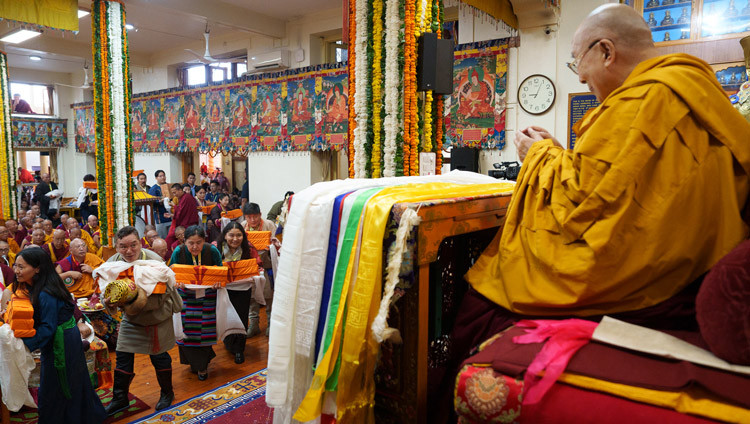
There followed a musical interlude as a group of young Tibetan men and women sang to His Holiness taking as their lyric the single verse he composed for his long life at the request of Dilgo Khyentsé Rinpoché. It includes the lines—May you live to adorn the earth, great bodhisattva, May you Tenzin Gyatso, Avalokiteshvara, live until the end of the cycle of existence.
His Holiness addressed the congregation:
“Here today we have representatives of gods and human beings gathering the auspicious circumstances for my long life, making your prayers intensely and sincerely. On my part it is clear that I have a connection to Avalokiteshvara. Ever since I was a child I’ve felt I had this connection and I have been able to serve the Buddha Dharma and the beings of Tibet. I still hope to live to be more than 130 years old.
“In China I met with Mao Zedong who told me that religion is poison. I didn’t respond, but I felt compassion for him. Later, I met Nehru. Throughout my life I’ve met people who had an interest in religion and those who did not. Of course, people have different mental dispositions, different inclinations and interests, as is clearly stated in our scriptures. This is quite natural.
“So, we need to engage in methods to bring about happiness and alleviate their sufferings that accord with people’s mental dispositions. Even those with no religious belief strive to be happy and avoid suffering. Modern scientists don’t talk much about religion, but they too seek to be happy and without suffering. Everyone does their best to be happy and to avoid misery. We Tibetans don’t want to suffer we want to be happy.
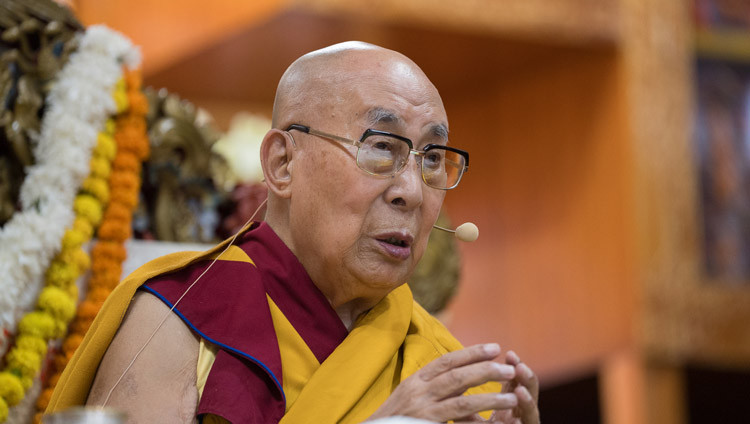
“We have lived in Tibet for centuries. We have prayed to Jowo Lokeshvara, Jo Yisshin Norbu and created collective karma. We, myself included, had to flee our country. And although we are physically separate, deep in my heart I always remain faithful to Jowo Lokeshvara. We all know that Avalokiteshvara gives his blessings. I have received clear indications that his blessings are here with me.
“As soon as I wake up in the morning, I make a prayer and reflect on bodhichitta in order to fulfil the aims of myself and others. In this way I generate the mind of awakening. I always intend and pray to be able to benefit all beings, including animals. For the last many years, Avalokiteshvara had been there on the crown of my head. I feel his blessings are always there and fall upon me.
“Human beings like you make offerings for my long life. Your dedication is unshakable and single pointed. During the cultural revolution in China, they made collective efforts which gave them strength. For us too, if we maintain our single-pointed faith in Avalokiteshvara and make supplications to him, it will yield results. I too will make such prayers.
“I came from Dhomey, the north-eastern part of Tibet and when I review the various prophecies, I feel I have the blessings of Avalokiteshvara and I’ve done my best so far. And I hope to live for another 30 or 40 years more.
“We’ve lost our country and live in exile in India, but I’ve been able to benefit beings. Living here in Dharamsala I intend to benefit beings and the Dharma as much as I can. I visualize Avalokiteshvara on the crown of my head and I trust in him. You too should make prayers to Avalokiteshvara.
“The essence of the Buddha Dharma is bodhichitta. We make this prayer—to fulfil the aims of myself and others I generate the mind of awakening. You should do that too. That’s all, thank you.”
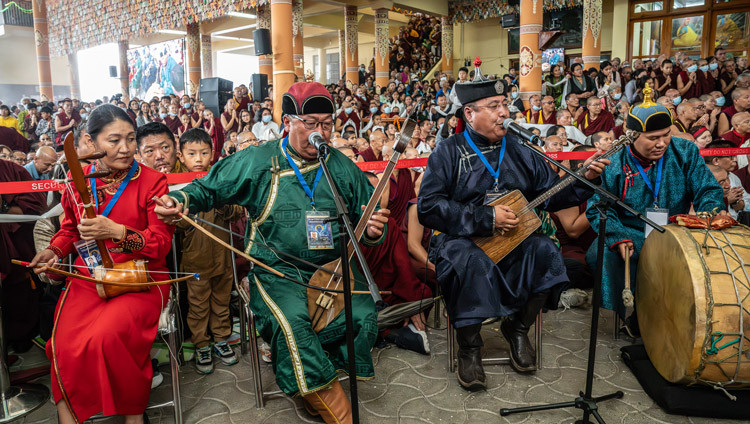
A thanksgiving mandala was offered to His Holiness in gratitude for his agreeing to remain 100 aeons.
The Lamas put on their traditional hats in their various shapes and colours, as the Prayer for the Non-sectarian Flourishing of the Buddha Dharma was recited. Everyone stood up as the Ghoton song was sung.
His Holiness left the temple saluting the guests and, as he walked to the lift, smiled and waved to eager well-wishers. From the edge of the courtyard he rode in a golf-cart back to his residence, a beaming smile on his face.












